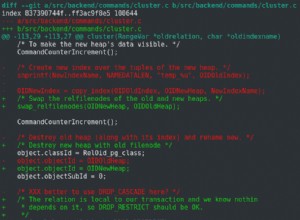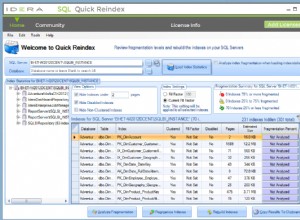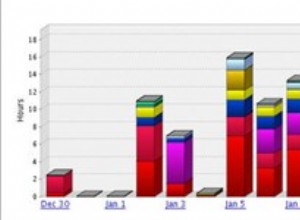Faiz,
che ne dici della seguente query, fa quello che vuoi per quanto ho capito. I commenti spiegano ogni passaggio. Dai un'occhiata ai CTE sui libri in linea. Questo esempio potrebbe anche essere modificato per utilizzare il nuovo comando MERGE per SQL 2008.
/* Test Data & Table */
DECLARE @Customers TABLE
(Dates datetime,
Customer integer,
Value integer)
INSERT INTO @Customers
VALUES ('20100101', 1, 12),
('20100101', 2, NULL),
('20100101', 3, 32),
('20100101', 4, 42),
('20100101', 5, 15),
('20100102', 1, NULL),
('20100102', 2, NULL),
('20100102', 3, 39),
('20100102', 4, NULL),
('20100102', 5, 16),
('20100103', 1, 13),
('20100103', 2, 24),
('20100103', 3, NULL),
('20100103', 4, NULL),
('20100103', 5, 21),
('20100104', 1, 14),
('20100104', 2, NULL),
('20100104', 3, NULL),
('20100104', 4, 65),
('20100104', 5, 23) ;
/* CustCTE - This gives us a RowNum to allow us to build the recursive CTE CleanCust */
WITH CustCTE
AS (SELECT Customer,
Value,
Dates,
ROW_NUMBER() OVER (PARTITION BY Customer ORDER BY Dates) RowNum
FROM @Customers),
/* CleanCust - A recursive CTE. This runs down the list of values for each customer, checking the Value column, if it is null it gets the previous non NULL value.*/
CleanCust
AS (SELECT Customer,
ISNULL(Value, 0) Value, /* Ensure we start with no NULL values for each customer */
Dates,
RowNum
FROM CustCte cur
WHERE RowNum = 1
UNION ALL
SELECT Curr.Customer,
ISNULL(Curr.Value, prev.Value) Value,
Curr.Dates,
Curr.RowNum
FROM CustCte curr
INNER JOIN CleanCust prev ON curr.Customer = prev.Customer
AND curr.RowNum = prev.RowNum + 1)
/* Update the base table using the result set from the recursive CTE */
UPDATE trg
SET Value = src.Value
FROM @Customers trg
INNER JOIN CleanCust src ON trg.Customer = src.Customer
AND trg.Dates = src.Dates
/* Display the results */
SELECT * FROM @Customers




